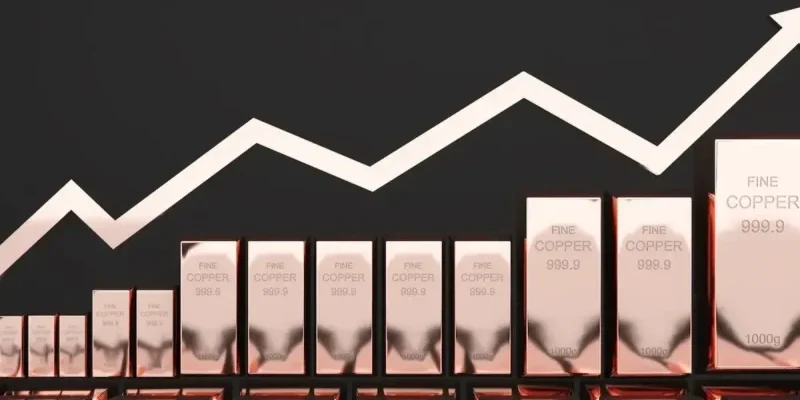
While gold is often steals headlines, copper is arguably the most essential resource for the modern world.
However, as demand for the base metal grows, supply is becoming increasingly restricted — in fact, major mines like Codelco’s Chuquicamata mine in Peru and Rio Tinto’s (ASX:RIO,NYSE:RIO,LSE:RIO) Bingham Canyon mine in Utah, which are over a century old, are returning lower grades and don’t have replacements set to come online.
This year’s copper outlook panel at the Vancouver Resource Investment Conference brought together industry experts Rick Rule, Lobo Tiggre and Ivan Bebek to discuss the state of the copper sector and what investors should know.
Copper demand to rise with or without AI, EVs
It’s hard to talk about copper without mentioning the energy transition, artificial intelligence (AI) and electric vehicles (EVs), but, Tiggre, who is CEO of IndependentSpeculator.com, emphasized that demand will rise with or without them.
“How much EV demand will there be? I don’t care; copper demand is going up without it. How much will AI turbocharge it? I don’t care; copper demand is going up anyway, and it’s supply constrained,” he said.
Rule shared that sentiment, noting how high demand is from developing nations alone.
“There are 1 billion people with no access to primary electricity; 2 billion people on Earth who have access to intermittent or unaffordable electricity,” said Rule, who is proprietor at Rule Investment Media. He went on to note that the copper boom between 2000 to 2010 could be attributed to the urbanization of China.
Ivan Bebek, president and CEO of Coppernico Metals (TSX:COPR,OTCQB:CPPMF), also discussed how the global population and urbanization are driving demand for copper.
“Construction is huge. In the early ’80s, the population was around 4 billion people; we’re now pushing 8 billion. So just think about that development curve and how much that has changed,’ he said.
‘You know, the EV thing is one thing, but mining construction is huge.’
Bebek went on to explain how urban centers are increasing their density to accommodate population increases. Homes built during the baby boom era are being torn down and replaced with condos. He sees this everywhere he goes.
“Copper hasn’t gone away. As much as we want to focus on EVs, there’s naturally a position where there’s going to be a lot of development that’s going to draw a lot more copper,” Bebek said.
Supply a growing concern as copper mines age
Supply is another key part of the copper equation, and it’s being increasingly constrained.
Part of the problem is financing in the industry, which was a theme throughout the conference. Junior companies dominate the exploration space and in many ways function co-dependently with large mining operators.
Over the last dozen years or so, money hasn’t been flowing down to the juniors from the well-financed majors. Instead, capital has been focused on mergers, share buybacks and dividends
The result is that majors aren’t adding to their mineral reserves, and juniors aren’t finding significant deposits.
“Buying isn’t building, so this isn’t bringing any more copper into the world,’ said Tiggre.
‘The discoveries have to happen. This is not an ‘if’ question — it’s a ‘when’ question. And the low-hanging fruit has already been picked. So somebody has to go out there and discover the stuff,” he added.
Copper mines operate on economies of scale, and small mines in the sector generally aren’t feasible. The industry’s mines are some of the largest and most productive in the world, but they’re also some of the oldest.
Rule described how, at 45 years old, BHP’s (ASX:BHP,NYSE:BHP,LSE:BHP) Escondida mine in Chile is still regarded as a young mine, especially in comparison to Chuquicamata and Bingham Canyon. While these are all massive operations, they are now suffering from lower grades, and depleting copper reserves.
Rule suggested that replacing these aging giants should have started 25 years ago, not today.
“And we did it, we found it — one deposit: Resolution. Wonderful deposit. A billion tonnes of ore in a great place between copper mines, towns, roads, highways — everything. One and a half percent copper, three times the average grade worldwide. It’s been stuck in permitting for 26 years,” he said.
Rule’s reference to the Rio Tinto and BHP joint venture outlines one of the critical problems faced by the industry today. It can take 25 years or more to take a copper project from discovery to production.
The majority of that time is spent on permitting, and while some jurisdictions are easier than others in that regard, building a copper mine is no easy task. It requires considerable capitalization and risk.
With that in mind, Rule advised mining companies to focus on scale.
‘If you’re going to take big risks, you gotta be shooting for big rewards.”
Overall, the panelists agreed that deficits in copper supply will challenge the industry in the coming years.
Is now a good time to invest in copper?
With a supply deficit expected to impact copper in the next few years, should investors enter the space now?
All three panelists are bullish on copper, but each of them offered a different opinion.
Rule suggested looking at the people involved in the companies. More specifically, he told the audience he wants to see a team with experience specific to mining or exploring for copper.
“You want to deal with somebody who knows what porphyry rock packages look like. You don’t necessarily want just exploration experience; you want access to copper exploration experience. The experience that the team got the reputation on has to be relevant to the task at hand,” he explained.
From Bebek’s point of view, it comes down to capital. “Everything about copper is expensive, and that’s where the rewards are worthwhile. My main thing would be to ask about the capital that they have or the line of selling capital. You can also look at share structure to see if they’re in a financial state with how many shares they have out.’
He also suggested that investors should not be afraid to ask how much management has invested in the stock. “If they’re not buying their shares of their company at cheap prices, why should you?”
Perhaps the most simple and direct advice came from Tiggre, who discussed understanding a project’s quality.
“Crap is crap. Crap at higher prices is still crap. Crap at lower prices is still crap,’ he said.
‘If you’ve got a copper project that’s been known for decades and it’s still on the ground and it’s not held up by permitting, it’s still in the ground because it wasn’t economic.’
Securities Disclosure: I, Dean Belder, hold no direct investment interest in any company mentioned in this article.








